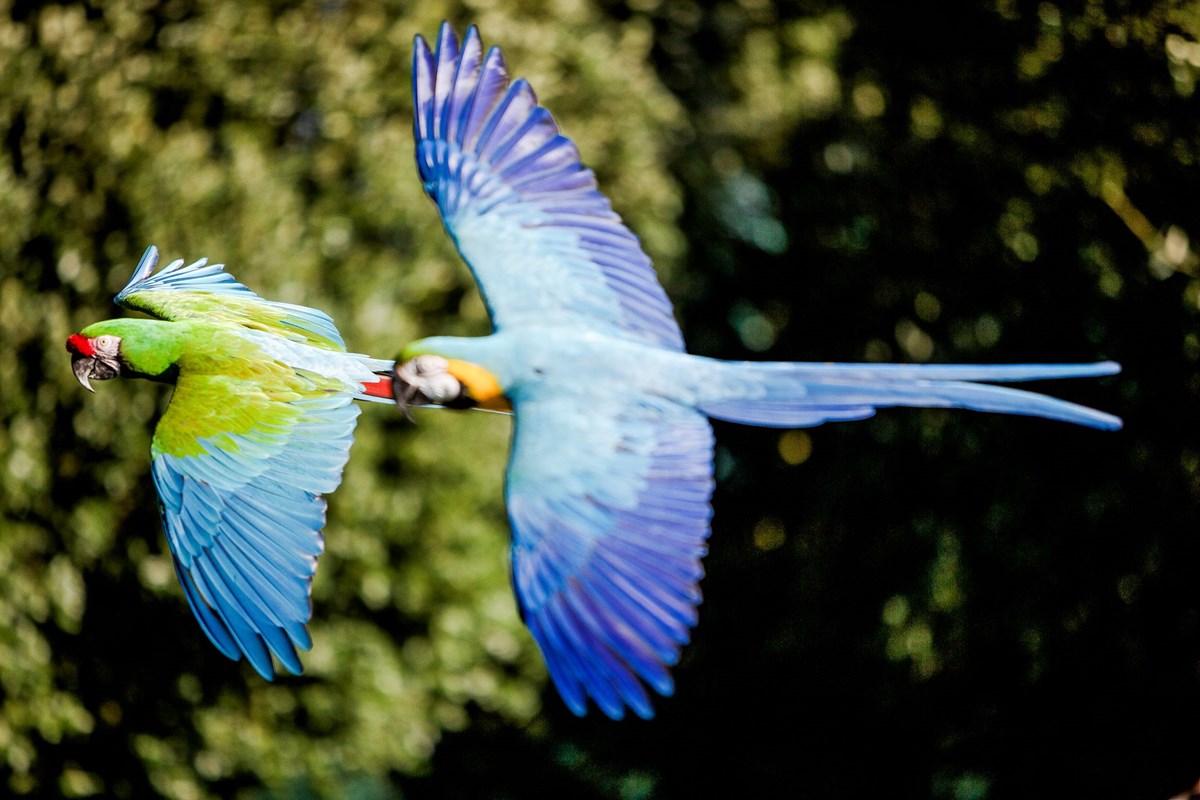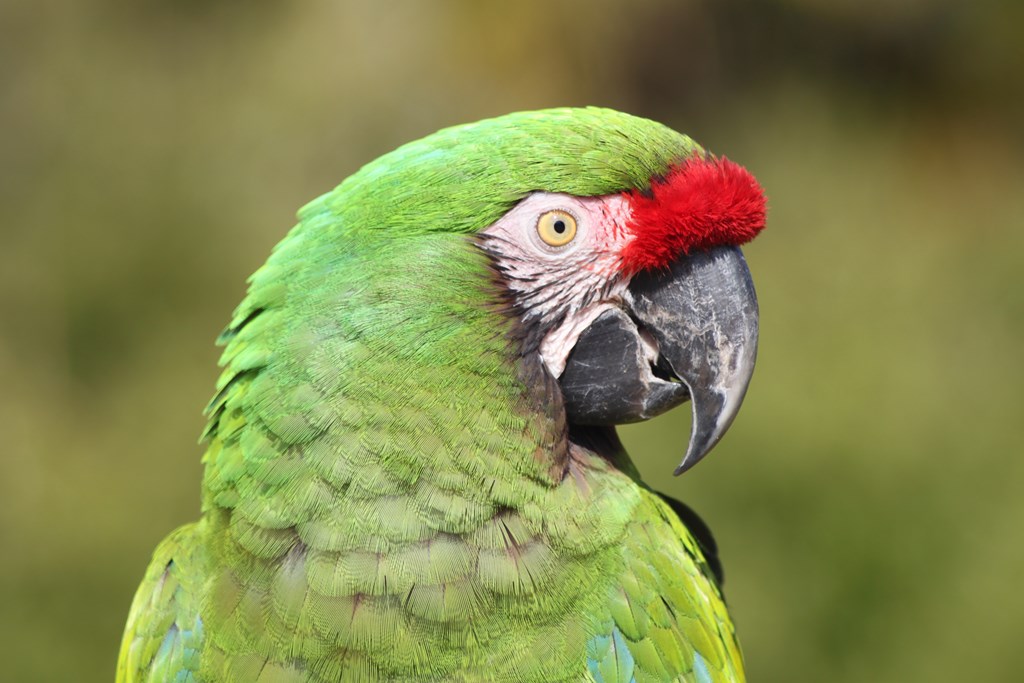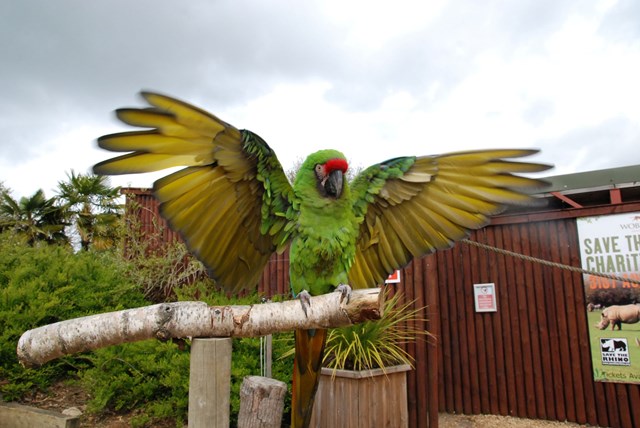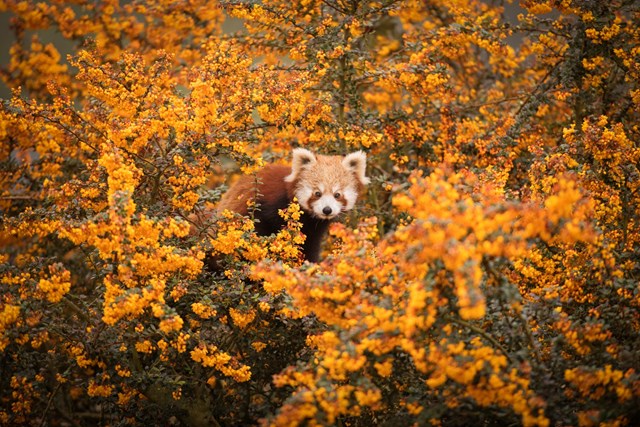Overview
The military macaw is a medium-sized macaw, native to Mexico and South America. They are mostly green, with a patch of red feathers just above their beak.
Experience Woburn Safari Park’s free flying bird demonstration, see these magnificent parrots soaring and swooping in the Birds in Action Amphitheatre. Learn about these intelligent birds, how they adapt and survive in the wild.


All about us
| Distribution: | Mexico and South America |
|---|---|
| Habitat: | Mountainous terrain, woodland |
| Height: | 70-84cm (beak to tail), Wingspan 99–110cm |
| Weight: | 900–1,100g |
| Lifespan: | Up to 60 years |
| Threats: | Habitat loss, hunting and pet trade |
About us
Scientific name: Ara militaris
In the wild, these birds can choose their partner before they even reach the age of maturity. The wings of these paired birds are close together when in flight as if they are almost touching. They leave their nesting area during the day to feed. Birds of prey are the biggest predators to parrots although monkeys, and other tree-dwelling mammals and snakes, can take parrot eggs and young chicks. When a flock of parrots become aware of a potential predator it quickly falls silent before noisily exploding from cover, the sudden noise and movement causes temporary confusion for the predator. During the night they seek safety in tree hollows.

Military macaws are mostly green. They have a patch of bright red feathers just above their beak. Their back and wings are green apart from the flight feathers which are blue. Their undersides of the flight feathers are a yellowish olive-green. Their under tail feathers are blue and the upper tail feathers start off red, merge into green and then turn blue. Their beak is black and the naked skin of cheeks is pinkish-white with lines of very small, isolated black feathers. Their iris’ (eyes) are pale yellow and their legs dark grey.
Adult female and male military macaws are similar in size, weight and colour. All species of Macaws are monomorphic, which means that there are no obvious differences between the sexes, not even by their plumage or physical indicators. Young macaws will have dark brown pupils while an adult bird will have yellow rings around the pupils, and the plumage of young birds is duller compared to the adults. To determine the gender of adult birds, a blood test or DNA test could be taken.
Parrots mainly eat plants. Seeds, fruits, blossoms, buds, leaves, berries, nuts and sometimes bark are principal known food items. The Macaws are structurally adapted, with their massively powerful bills (beaks) to exploit various palm nuts. They have the ability to manipulate food items, moving them with their feet, testing them with their dry tongues, and tossing food around in their beaks.
A wide range of parrots visit earth banks to take mineral rich soil where they congregate in very large numbers. Visiting clay banks to take mineral deposits has a very important function as this helps neutralise the toxic effects of poisons ingested from fruits or plants.
Today the military macaw is listed on CITES as Appendix I, meaning these birds are vulnerable in the wild. Parrots at risk in the wild face a wide range of pressures. The main sources of threat arise from habitat loss, hunting and introduced species cause problems for native wildlife because of predation and competition for food. Collection of birds for the live pet trade has been a major threat for many species of parrots. These birds high level of intelligence, potential for tameness, bright plumage and the ability to mimic human voices, have led to the parrot’s popularity as cage birds.
Zoos and other institutions seek to maintain captive populations in order to safeguard against possible extinction in the wild. This breeding is sometimes well coordinated and is orchestrated through the use of studbook keepers. Other breeding is undertaken commercially to meet demands of the pet trade, sometimes to the extent that species have self-sustaining captive populations meaning catching of wild parrots no longer needs to take place (for example budgerigar, cockatiel and several species of lovebird).
There are unfortunately draw backs to captive breeding. Some of the species are at such low levels that trapping for captive breeding would only worsen their wild status. Captive breeding may do nothing to reduce the pressures which have rendered a parrot species scarce. Habitat loss, illegal capture or the effects of introduced predators may continue. If successful breeding is achieved, there may then be no place to release captive bred birds to recolonize.
Future proposed conservation action plans consist of monitoring the largest known populations and control capture and trade of wild birds. Improve the management and awareness initiatives in and around national parks.
Parrots at risk in the wild face a wide range of pressures. The main sources of threat arise from habitat loss, hunting and introduced species. Bringing a new species into the habitat can cause problems for native wildlife because of predation and competition for food. Collection of birds for the live pet trade has been a major threat for many species of parrots. These birds high level of intelligence, potential for tameness, bright plumage and the ability to mimic human voices, have led to the parrot’s popularity as cage birds.
Zoos and other institutions seek to maintain captive populations in order to safeguard against possible extinction in the wild. This breeding is well-coordinated and orchestrated through the use of studbook keepers. Other breeding is undertaken commercially to meet demands of the pet trade, sometimes to the extent that species have self-sustaining captive populations that no longer need to be increased with wild caught birds (for example budgerigar, cockatiel, and several species of lovebird).
There are unfortunately drawbacks to captive breeding. Some of the species are at such low levels that trapping for captive breeding would only worsen their wild status. Captive breeding may do nothing to reduce the pressures which have rendered a parrot species scarce. Habitat loss, illegal capture or the effects of introduced predators may continue meaning if successful breeding is achieved in captivity, there may not be a wild habitat to release the parrots into.
There is another macaw species, which is very similar to the military macaw. It is the great green macaw (ara ambigua) which is native to Central America. The two taxa are so similar that they are also known as the "lesser" (militaris) and "greater" (ambigua) military macaw.
A parrot’s vision is remarkably different from ours. Like many avian species, their ability to see into the ultraviolet spectrum enables them to see colours we cannot even imagine.

